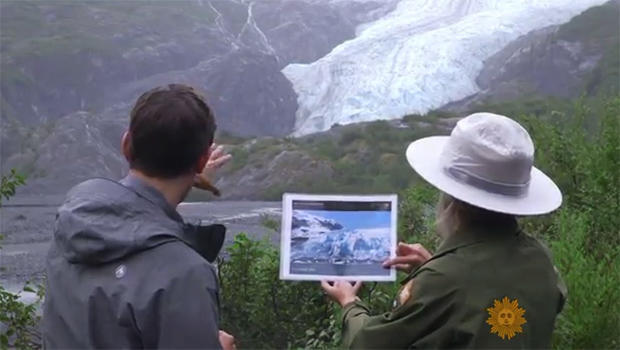On The Trail: Disappearing glaciers
Glacier National Park in Montana has a name to live up to. But it’s a name that seems to be living on borrowed time, as Conor Knighton discovered On the Trail:
Like most photographers, Dan Fagre is obsessed with getting the perfect shot.
By the end of the day, we’ll have hiked around 12 miles all together -- up steep mountain passes, across icy streams -- all to photograph a small slice of Glacier National Park.
Visitors take snapshots of the views, but when Dan looks through his lens, he sees something different. He’s trying to take a picture of what ISN’T there -- the tons and tons of ice that have disappeared.
Fagre is an ecologist with the U.S. Geological Survey. Using material from the park’s archive, the USGS has been replicating old photos.
Left: Boulder Glacier at Glacier National Park in 1932. Right: The glacier in 2005.
“Rephotography is really interesting -- it’s a little bit of a detective story,” Fagre said. “You’re trying to find the exact spot that a photographer stood [at] decades before and shoot the exact same picture, then compare the changes between those two time spans.”
In a short amount of time, the change has been dramatic -- as evident by Knighton and Fagre walking at a spot which had been completely icebound 50 years earlier.
The sign says Glacier National Park. But some models have suggested that these Montana mountains will lose ALL of their glaciers by 2030. Soon there won’t be any ice left to photograph.
“You know, like a lot of people, I really like the glaciers in Glacier Park,” Fagre said. “And while I will be sad to see them go personally, I think my role as a scientist is to make sure that everybody understands the pace at which they’re disappearing, and the reasons for that, so that, again, better decisions could be made societally.”
The reason is climate change; the planet is heating up. Park Service Director John Jarvis has said that “climate change is fundamentally the greatest threat to the integrity of our national parks that we have ever experienced.”
Visiting the parks this year, Knighton has experienced it firsthand. At Kenai Fjords National Park in Alaska, the massive glaciers will survive longer than those in Montana, but they’re still shrinking.
Walking into the park, you pass the signs -- 1899, 1926, 1961, all the way to 2005 -- indicating where the glacier used to be. And all signs point to the retreat speeding up.
Last year, President Obama paid a visit to Kenai Fjords to talk about climate change.
In 2016, since the president’s visit, the glacier has already retreated more than 250 feet. That’s a new record.
“The glaciers have been receding,” said Park Ranger Fiona North. “And the surprising thing, the thing that lets us know that this is an indication of climate change, is the rate of retreat has increased drastically.”
At the park Ranger North uses photos to illustrate the before and after.
From Alaska to Montana, photos that were originally taken to publicize these natural wonders are now being used to publicize how they’re disappearing. It packs a punch that a chart or a graph can’t deliver.
“I think people are extremely visual,” said Dan Fagre. “And, you know the old saying about one painting or photo being worth 1,000 words. We get a lot of information visually, and we tend to trust that even more than what we hear.”
With these photos, the message is clear: The pace of change is anything but glacial.
For more info:
- Glacier National Park, Montana (nps.gov)
- Northern Rocky Mountain Science Center (NOROCK)
- Kenai Fjords National Park, Alaska (nps.gov)
Also visited by Knighton while “On The Trail”:
- Crater Lake National Park, Oregon
- Denali National Park, Alaska
- Mesa Verde National Park, Colorado
- Joshua Tree National Park, California
- Death Valley National Park, California-Nevada
- Virgin Islands National Park, U.S. Virgin Islands
- Shenandoah National Park, Virginia, and Mount Rainier National Park, Washington
- Great Sand Dunes National Park, Colorado
- Zion National Park, Utah
- Petrified Forest National Park, Arizona
- Biscayne National Park, Florida
- Big Bend National Park, Texas
- Everglades National Park, Florida
- Hot Springs National Park, Arkansas
- Acadia National Park, Maine
- Mammoth Cave National Park, Kentucky

